Examining the UK Unemployment Rate During the COVID-19 Pandemic
VerifiedAdded on 2023/06/17
|13
|924
|322
Report
AI Summary
This report examines the changes in the UK's unemployment rate during the COVID-19 pandemic, referencing data from the Office for National Statistics and other sources. It highlights the surprising resilience of the job market due to government interventions and company adaptations. The report details fluctuations in employment, unemployment, and economic inactivity among different demographics, noting the impact of the pandemic on specific age groups. It further explores predictions from the Treasury and the OBR regarding future unemployment trends. The conclusion emphasizes the role of job-protection programs and vaccinations in mitigating potential unemployment increases, acknowledging the significant impact of the furlough scheme in preserving jobs during the crisis. The report cites resources from BBC, Trading Economics, Reuters and Business Standard.

Economics For Business
Paraphrase This Document
Need a fresh take? Get an instant paraphrase of this document with our AI Paraphraser
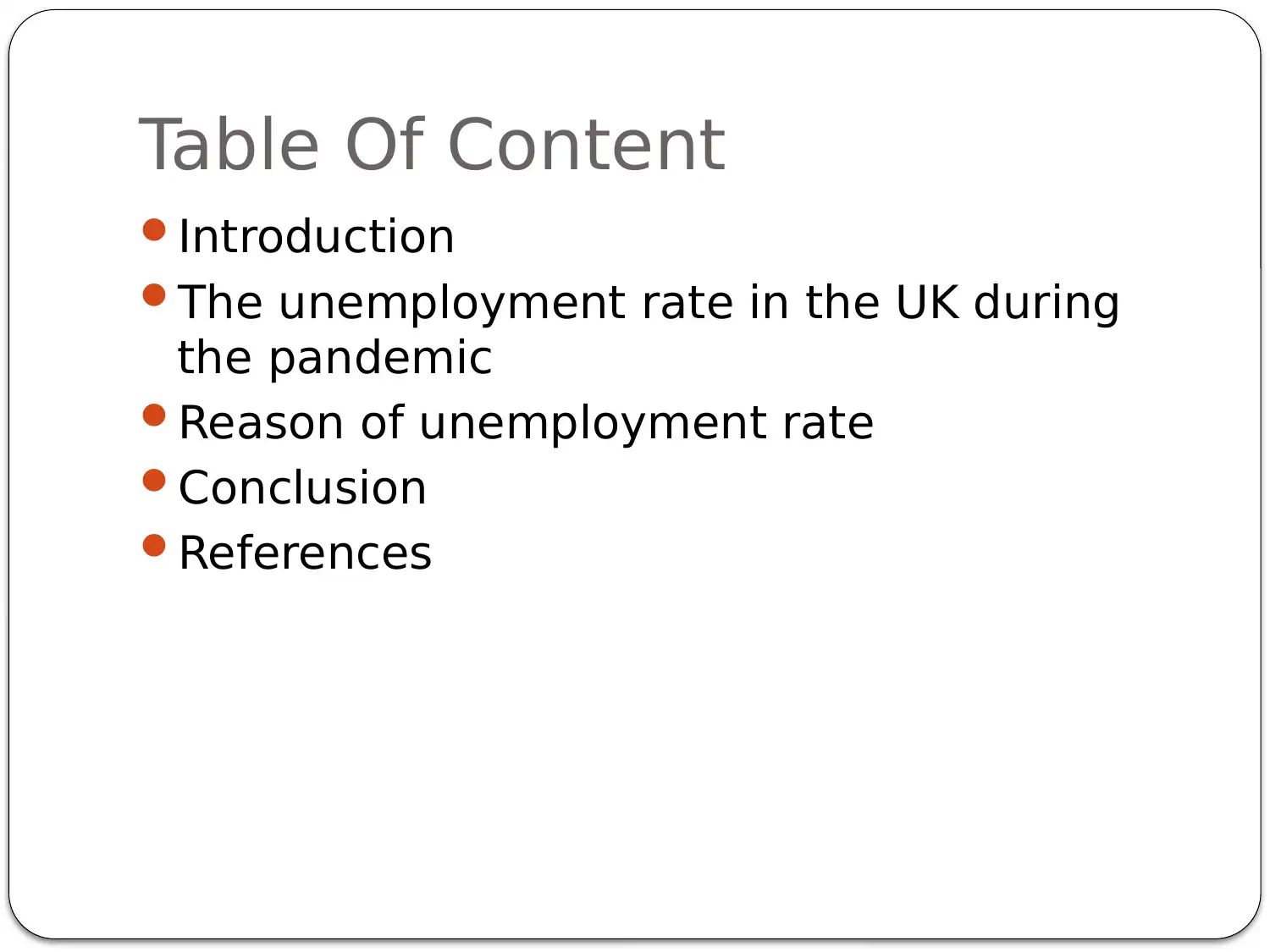
Table Of Content
Introduction
The unemployment rate in the UK during
the pandemic
Reason of unemployment rate
Conclusion
References
Introduction
The unemployment rate in the UK during
the pandemic
Reason of unemployment rate
Conclusion
References
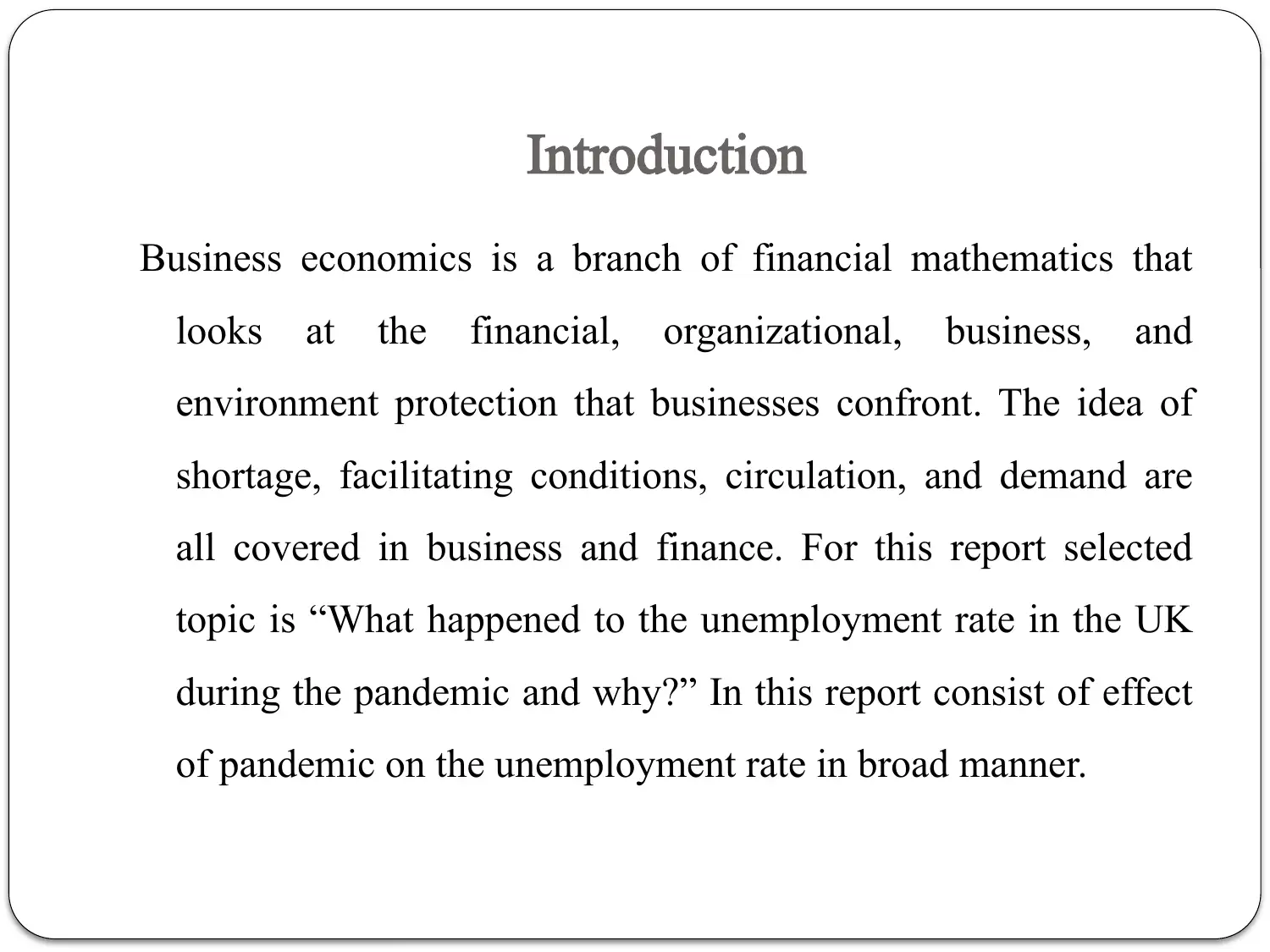
Introduction
Business economics is a branch of financial mathematics that
looks at the financial, organizational, business, and
environment protection that businesses confront. The idea of
shortage, facilitating conditions, circulation, and demand are
all covered in business and finance. For this report selected
topic is “What happened to the unemployment rate in the UK
during the pandemic and why?” In this report consist of effect
of pandemic on the unemployment rate in broad manner.
Business economics is a branch of financial mathematics that
looks at the financial, organizational, business, and
environment protection that businesses confront. The idea of
shortage, facilitating conditions, circulation, and demand are
all covered in business and finance. For this report selected
topic is “What happened to the unemployment rate in the UK
during the pandemic and why?” In this report consist of effect
of pandemic on the unemployment rate in broad manner.
⊘ This is a preview!⊘
Do you want full access?
Subscribe today to unlock all pages.

Trusted by 1+ million students worldwide
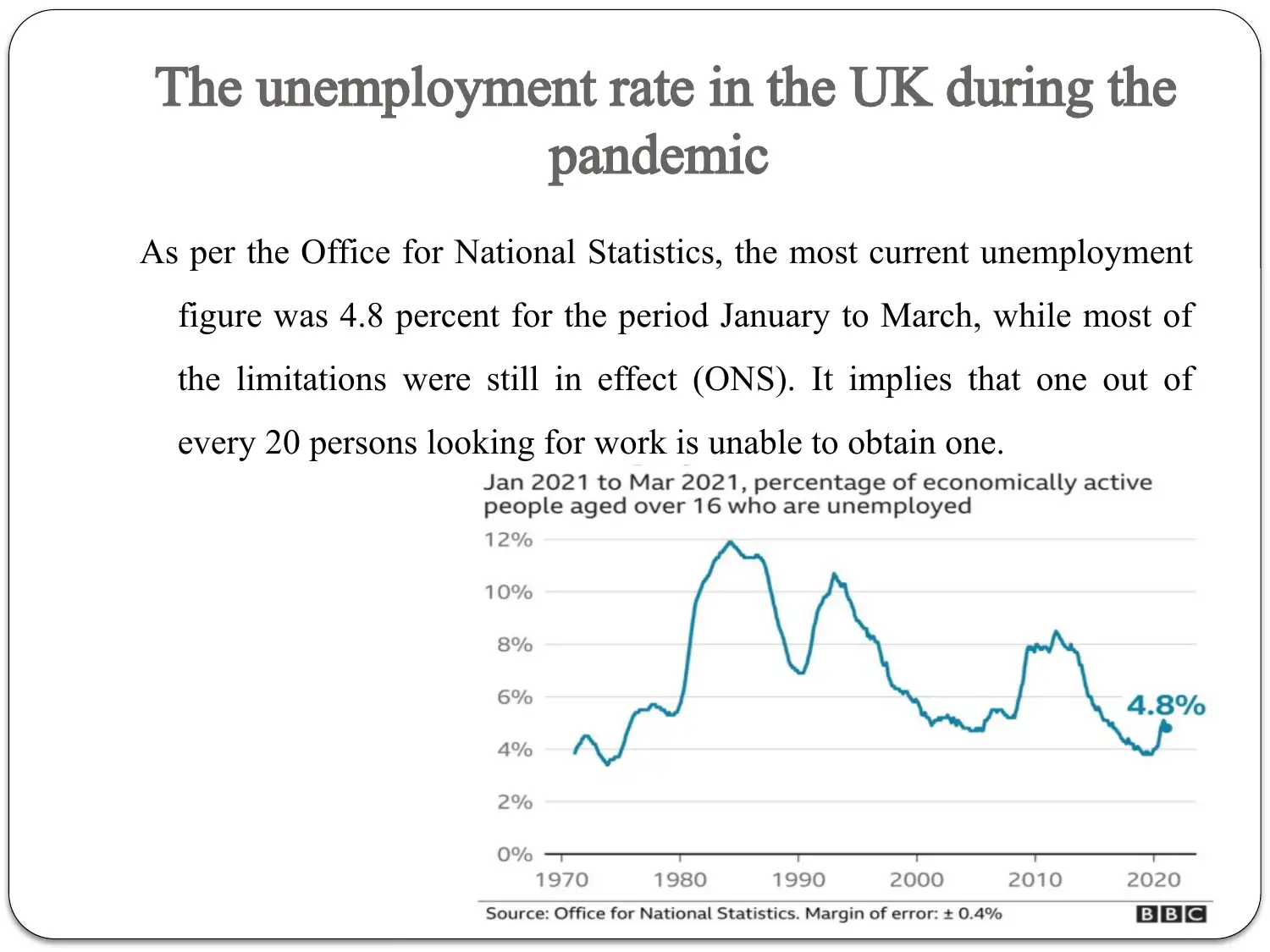
The unemployment rate in the UK during the
pandemic
As per the Office for National Statistics, the most current unemployment
figure was 4.8 percent for the period January to March, while most of
the limitations were still in effect (ONS). It implies that one out of
every 20 persons looking for work is unable to obtain one.
pandemic
As per the Office for National Statistics, the most current unemployment
figure was 4.8 percent for the period January to March, while most of
the limitations were still in effect (ONS). It implies that one out of
every 20 persons looking for work is unable to obtain one.
Paraphrase This Document
Need a fresh take? Get an instant paraphrase of this document with our AI Paraphraser
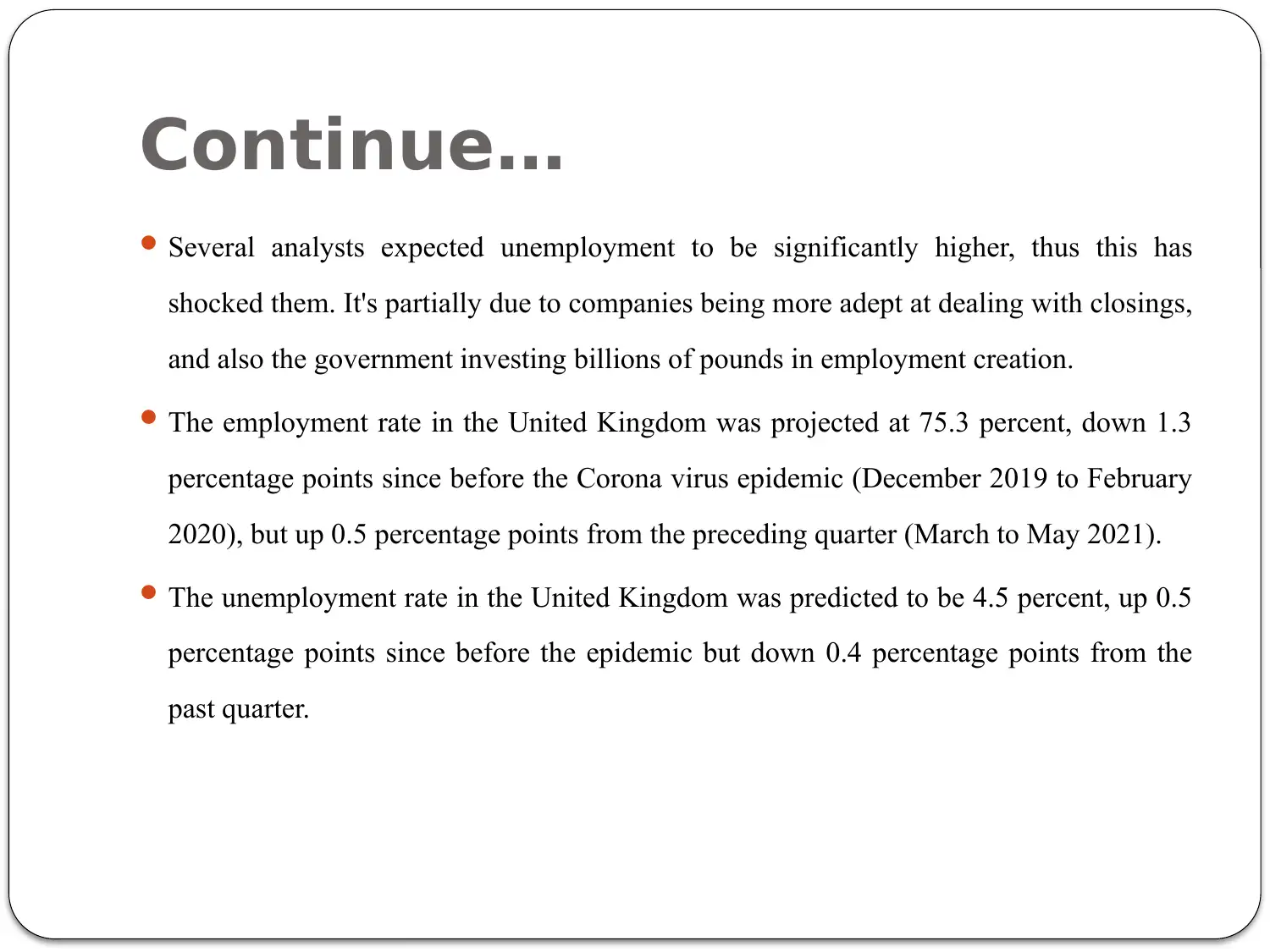
Continue…
Several analysts expected unemployment to be significantly higher, thus this has
shocked them. It's partially due to companies being more adept at dealing with closings,
and also the government investing billions of pounds in employment creation.
The employment rate in the United Kingdom was projected at 75.3 percent, down 1.3
percentage points since before the Corona virus epidemic (December 2019 to February
2020), but up 0.5 percentage points from the preceding quarter (March to May 2021).
The unemployment rate in the United Kingdom was predicted to be 4.5 percent, up 0.5
percentage points since before the epidemic but down 0.4 percentage points from the
past quarter.
Several analysts expected unemployment to be significantly higher, thus this has
shocked them. It's partially due to companies being more adept at dealing with closings,
and also the government investing billions of pounds in employment creation.
The employment rate in the United Kingdom was projected at 75.3 percent, down 1.3
percentage points since before the Corona virus epidemic (December 2019 to February
2020), but up 0.5 percentage points from the preceding quarter (March to May 2021).
The unemployment rate in the United Kingdom was predicted to be 4.5 percent, up 0.5
percentage points since before the epidemic but down 0.4 percentage points from the
past quarter.
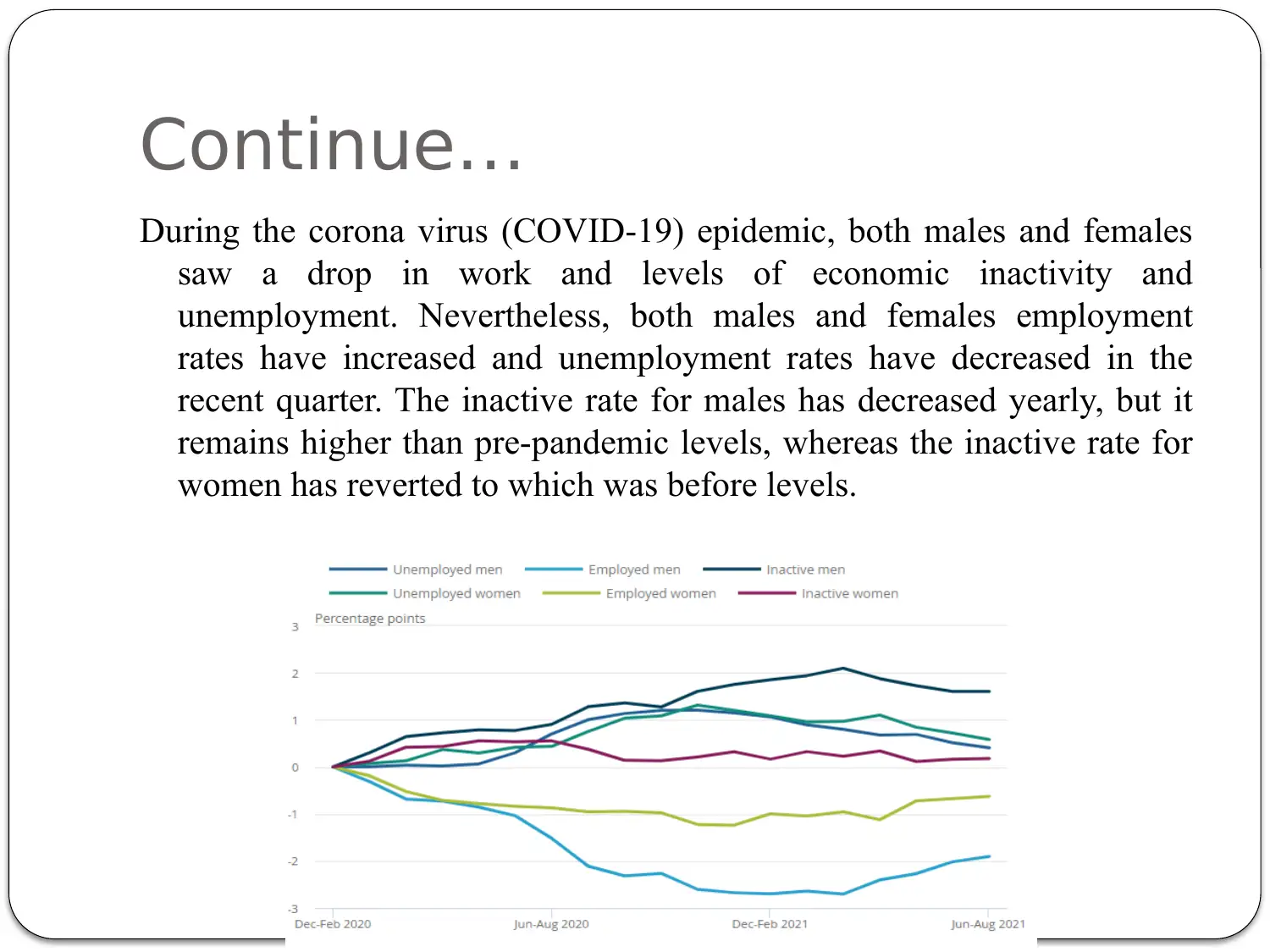
Continue…
During the corona virus (COVID-19) epidemic, both males and females
saw a drop in work and levels of economic inactivity and
unemployment. Nevertheless, both males and females employment
rates have increased and unemployment rates have decreased in the
recent quarter. The inactive rate for males has decreased yearly, but it
remains higher than pre-pandemic levels, whereas the inactive rate for
women has reverted to which was before levels.
During the corona virus (COVID-19) epidemic, both males and females
saw a drop in work and levels of economic inactivity and
unemployment. Nevertheless, both males and females employment
rates have increased and unemployment rates have decreased in the
recent quarter. The inactive rate for males has decreased yearly, but it
remains higher than pre-pandemic levels, whereas the inactive rate for
women has reverted to which was before levels.
⊘ This is a preview!⊘
Do you want full access?
Subscribe today to unlock all pages.

Trusted by 1+ million students worldwide

Continue…
In the three months to September 2021, the UK unemployment rate
fell to 4.3 percent, the smallest since July 2020 and well below
market predictions of 4.4 percent. Despite this, the rate was 0.3
percentage points than it was prior to the epidemic.
In the three months to September 2021, the UK unemployment rate
fell to 4.3 percent, the smallest since July 2020 and well below
market predictions of 4.4 percent. Despite this, the rate was 0.3
percentage points than it was prior to the epidemic.
Paraphrase This Document
Need a fresh take? Get an instant paraphrase of this document with our AI Paraphraser
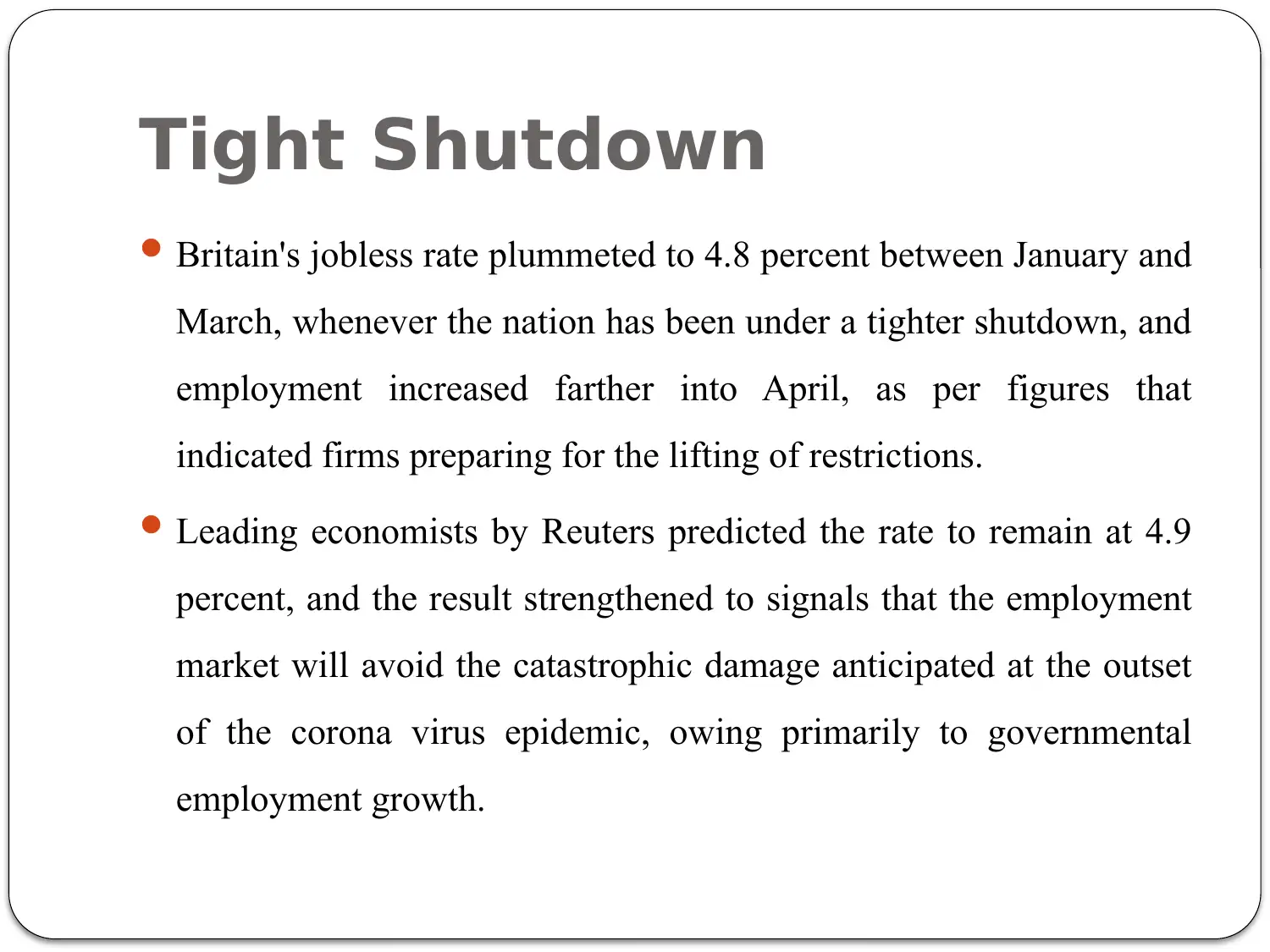
Tight Shutdown
Britain's jobless rate plummeted to 4.8 percent between January and
March, whenever the nation has been under a tighter shutdown, and
employment increased farther into April, as per figures that
indicated firms preparing for the lifting of restrictions.
Leading economists by Reuters predicted the rate to remain at 4.9
percent, and the result strengthened to signals that the employment
market will avoid the catastrophic damage anticipated at the outset
of the corona virus epidemic, owing primarily to governmental
employment growth.
Britain's jobless rate plummeted to 4.8 percent between January and
March, whenever the nation has been under a tighter shutdown, and
employment increased farther into April, as per figures that
indicated firms preparing for the lifting of restrictions.
Leading economists by Reuters predicted the rate to remain at 4.9
percent, and the result strengthened to signals that the employment
market will avoid the catastrophic damage anticipated at the outset
of the corona virus epidemic, owing primarily to governmental
employment growth.
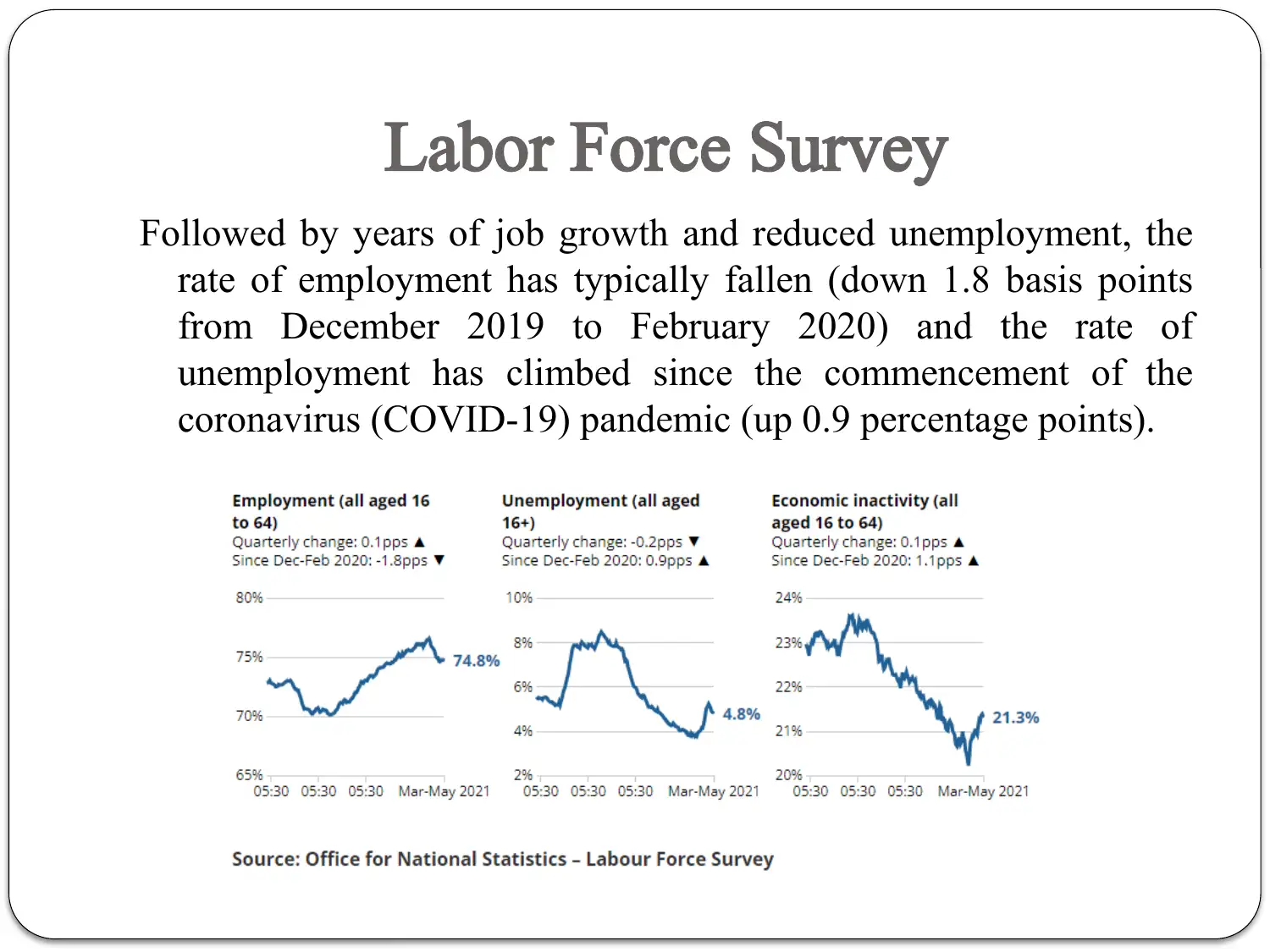
Labor Force Survey
Followed by years of job growth and reduced unemployment, the
rate of employment has typically fallen (down 1.8 basis points
from December 2019 to February 2020) and the rate of
unemployment has climbed since the commencement of the
coronavirus (COVID-19) pandemic (up 0.9 percentage points).
Followed by years of job growth and reduced unemployment, the
rate of employment has typically fallen (down 1.8 basis points
from December 2019 to February 2020) and the rate of
unemployment has climbed since the commencement of the
coronavirus (COVID-19) pandemic (up 0.9 percentage points).
⊘ This is a preview!⊘
Do you want full access?
Subscribe today to unlock all pages.

Trusted by 1+ million students worldwide
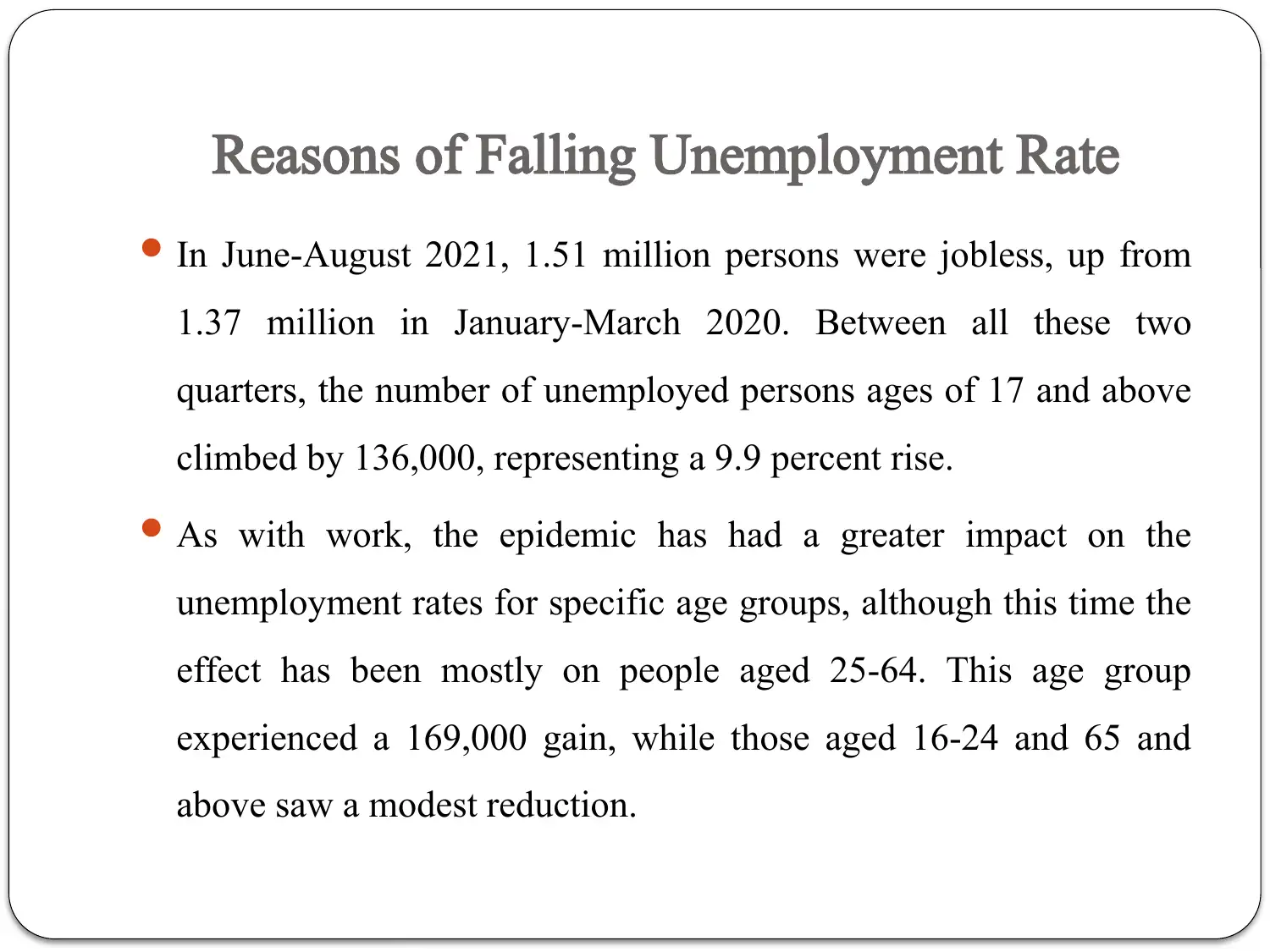
Reasons of Falling Unemployment Rate
In June-August 2021, 1.51 million persons were jobless, up from
1.37 million in January-March 2020. Between all these two
quarters, the number of unemployed persons ages of 17 and above
climbed by 136,000, representing a 9.9 percent rise.
As with work, the epidemic has had a greater impact on the
unemployment rates for specific age groups, although this time the
effect has been mostly on people aged 25-64. This age group
experienced a 169,000 gain, while those aged 16-24 and 65 and
above saw a modest reduction.
In June-August 2021, 1.51 million persons were jobless, up from
1.37 million in January-March 2020. Between all these two
quarters, the number of unemployed persons ages of 17 and above
climbed by 136,000, representing a 9.9 percent rise.
As with work, the epidemic has had a greater impact on the
unemployment rates for specific age groups, although this time the
effect has been mostly on people aged 25-64. This age group
experienced a 169,000 gain, while those aged 16-24 and 65 and
above saw a modest reduction.
Paraphrase This Document
Need a fresh take? Get an instant paraphrase of this document with our AI Paraphraser
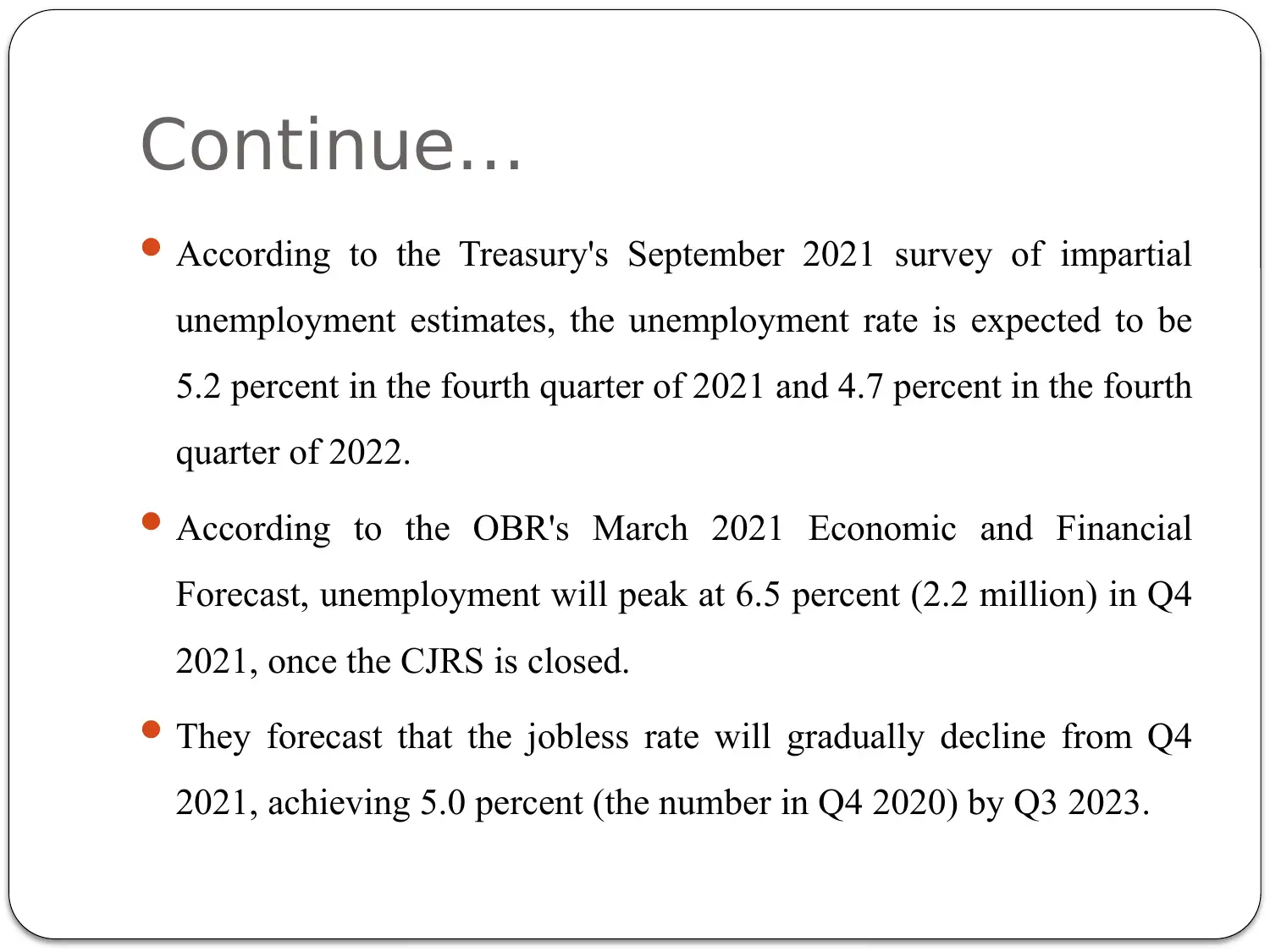
Continue…
According to the Treasury's September 2021 survey of impartial
unemployment estimates, the unemployment rate is expected to be
5.2 percent in the fourth quarter of 2021 and 4.7 percent in the fourth
quarter of 2022.
According to the OBR's March 2021 Economic and Financial
Forecast, unemployment will peak at 6.5 percent (2.2 million) in Q4
2021, once the CJRS is closed.
They forecast that the jobless rate will gradually decline from Q4
2021, achieving 5.0 percent (the number in Q4 2020) by Q3 2023.
According to the Treasury's September 2021 survey of impartial
unemployment estimates, the unemployment rate is expected to be
5.2 percent in the fourth quarter of 2021 and 4.7 percent in the fourth
quarter of 2022.
According to the OBR's March 2021 Economic and Financial
Forecast, unemployment will peak at 6.5 percent (2.2 million) in Q4
2021, once the CJRS is closed.
They forecast that the jobless rate will gradually decline from Q4
2021, achieving 5.0 percent (the number in Q4 2020) by Q3 2023.
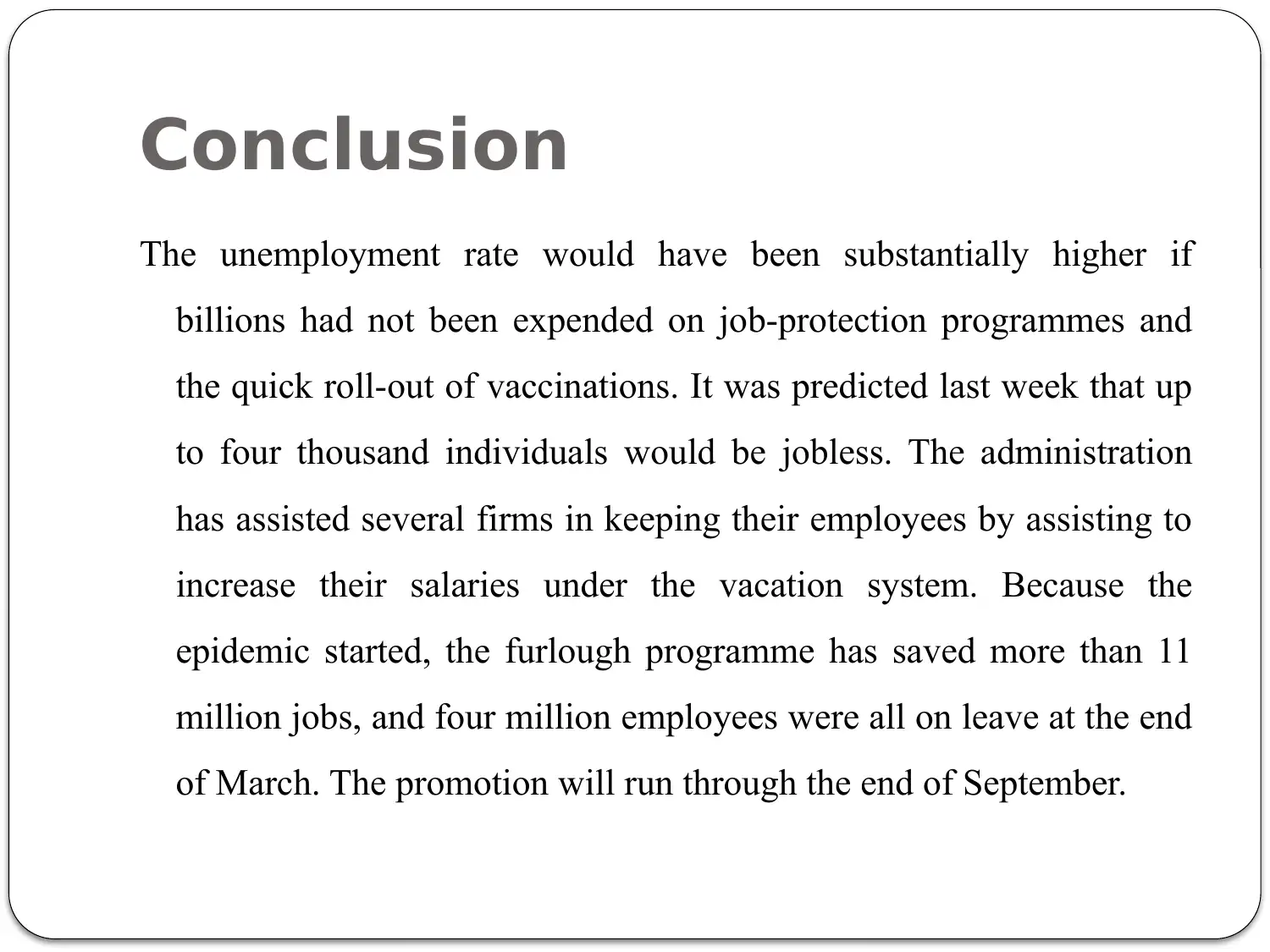
Conclusion
The unemployment rate would have been substantially higher if
billions had not been expended on job-protection programmes and
the quick roll-out of vaccinations. It was predicted last week that up
to four thousand individuals would be jobless. The administration
has assisted several firms in keeping their employees by assisting to
increase their salaries under the vacation system. Because the
epidemic started, the furlough programme has saved more than 11
million jobs, and four million employees were all on leave at the end
of March. The promotion will run through the end of September.
The unemployment rate would have been substantially higher if
billions had not been expended on job-protection programmes and
the quick roll-out of vaccinations. It was predicted last week that up
to four thousand individuals would be jobless. The administration
has assisted several firms in keeping their employees by assisting to
increase their salaries under the vacation system. Because the
epidemic started, the furlough programme has saved more than 11
million jobs, and four million employees were all on leave at the end
of March. The promotion will run through the end of September.
⊘ This is a preview!⊘
Do you want full access?
Subscribe today to unlock all pages.

Trusted by 1+ million students worldwide
1 out of 13
Related Documents
Your All-in-One AI-Powered Toolkit for Academic Success.
+13062052269
info@desklib.com
Available 24*7 on WhatsApp / Email
![[object Object]](/_next/static/media/star-bottom.7253800d.svg)
Unlock your academic potential
Copyright © 2020–2025 A2Z Services. All Rights Reserved. Developed and managed by ZUCOL.





